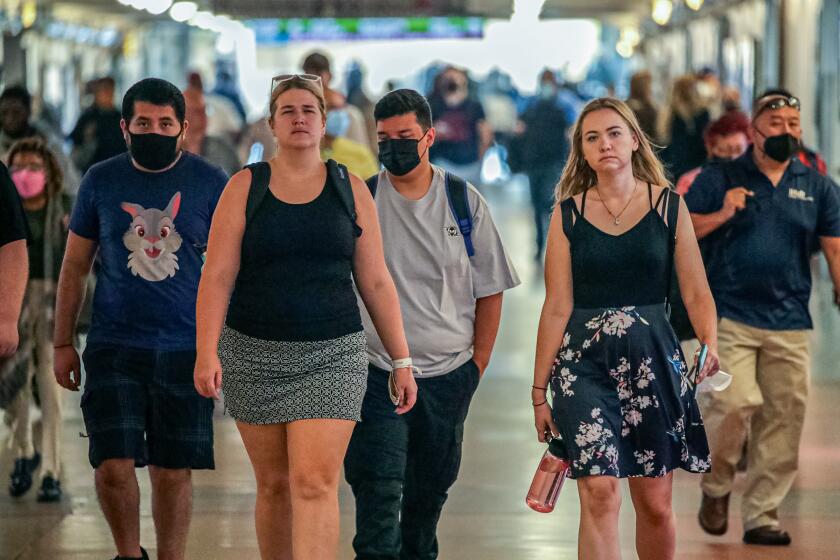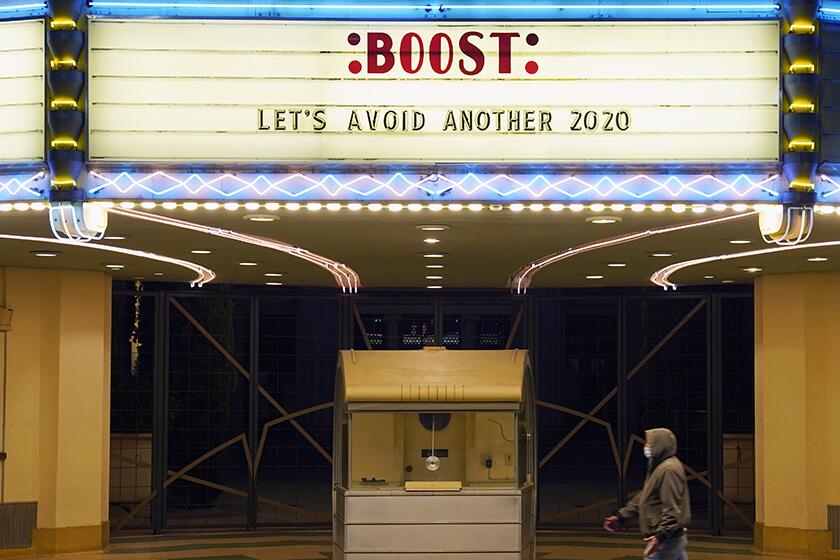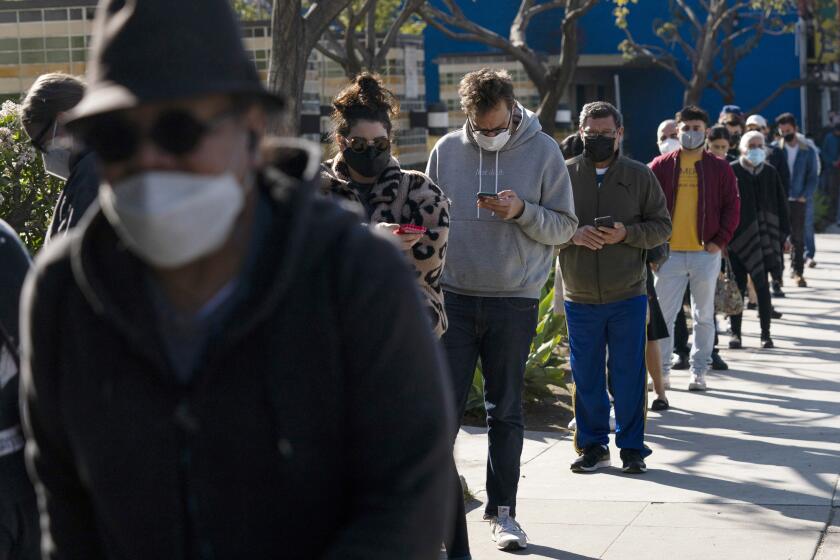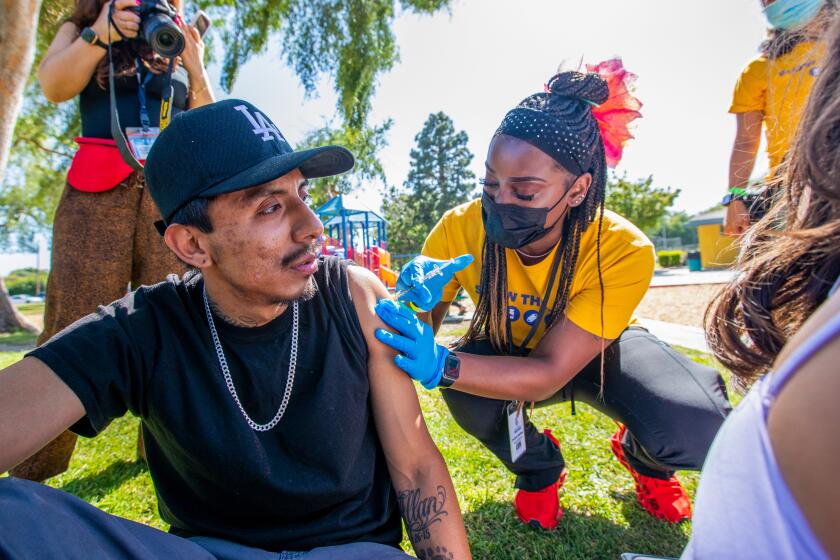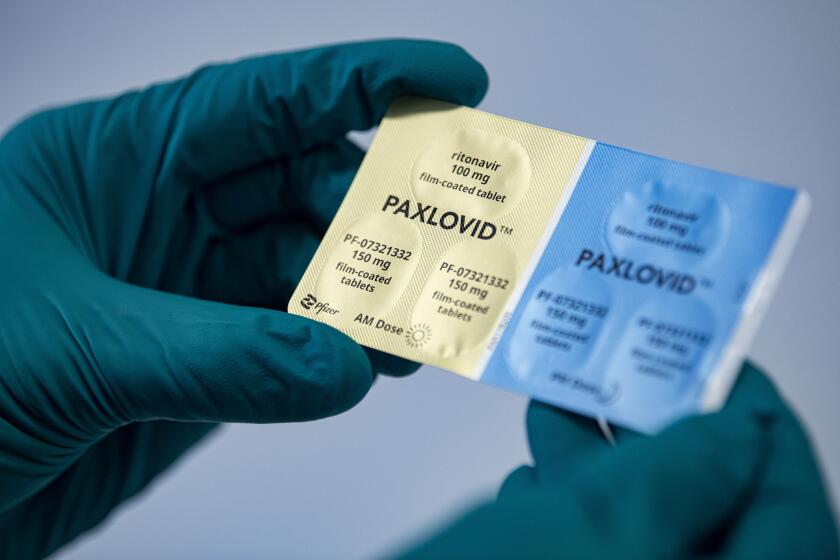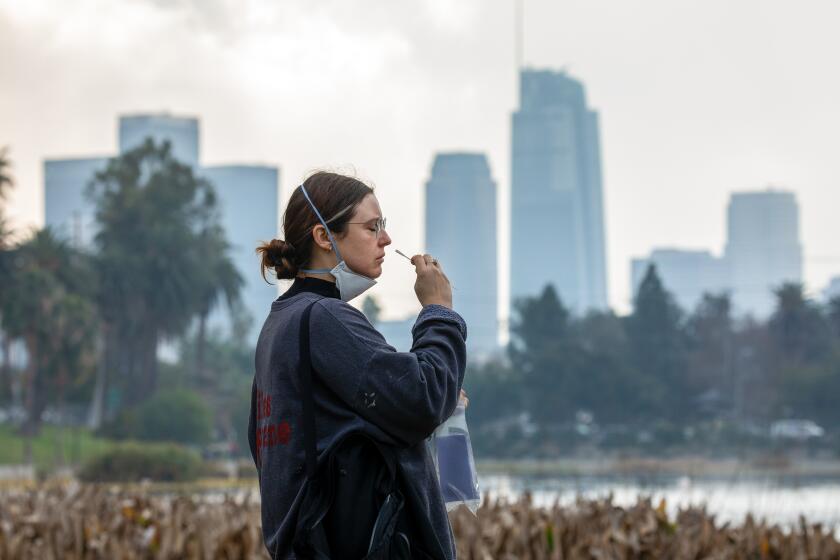Stunning spread of COVID subvariants brings high-risk summer to California
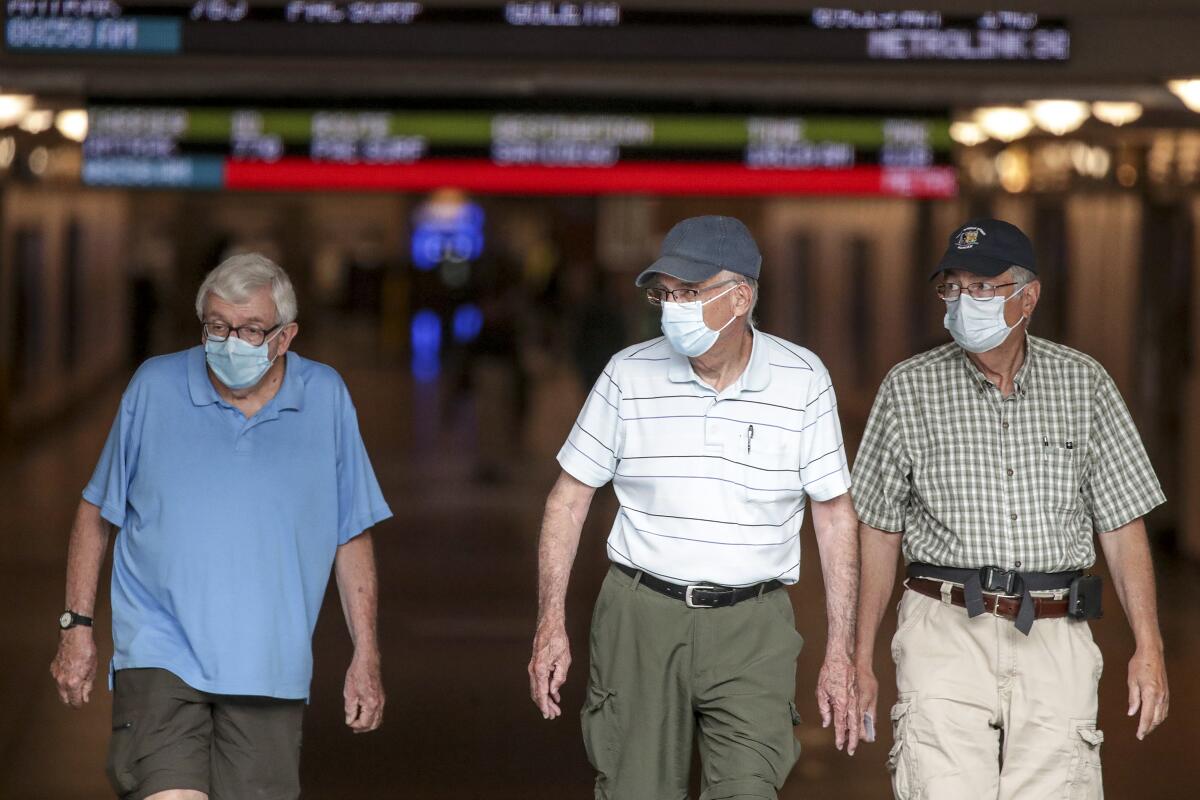
- Share via
California’s summer is being complicated by a dizzying array of Omicron subvariants that have emerged over the last several months.
The most dominant nationwide is BA.5, which officials say is not only highly contagious, but has increased the risk of coronavirus reinfection — perhaps just weeks after an earlier case.
According to federal estimates, BA.5 comprised 65% of the nation’s coronavirus cases over the weeklong period ending Saturday, an astonishing climb from a month ago, when it made up 17% of cases.
Among the impacts of the subvariant:
- Transmission levels have been consistently high across virtually all California counties.
- Los Angeles County is experiencing a renewed increase in cases, now up 14% week over week — ending a short period of relative stability following the Fourth of July that, in hindsight, likely was related to delays in reporting and reduced testing over the holiday.
- L.A. County has averaged about 5,900 coronavirus cases a day over the last week, its highest rate since early February. On a per capita basis, that’s 412 cases a week for every 100,000 residents. A rate of 100 or more is considered high.
- In L.A. County, the number of weekly coronavirus outbreaks in nursing homes in the last month has doubled.
- The increase in coronavirus infections, particularly at workplaces, has experts concerned. The county is urging employers with three or more COVID cases in a two-week period to consider encouraging workers to perform their tasks remotely when feasible.
- Weekly deaths have doubled in the past month in L.A. County, which is reporting about 100 COVID-19 deaths a week.
So what does the rest of the summer look like? Here is a breakdown of what we know:
Weekly COVID-19 deaths doubled in Los Angeles County over the last month, to 100 from 50 a week.
What can we expect?
It is hard to predict.
Clearly, California continues to see a wave of cases from the super-infectious family of Omicron subvariants, namely BA.5.
Coronavirus-positive hospitalizations also are increasing, raising the possibility that facilities could again come under strain. That’s no certainty, however, as a drop or stabilization in infections likely would trigger the same among healthcare systems.
And while hospitalizations remain far lower than during previous waves, the trendlines are troubling.
As of Tuesday, 4,377 coronavirus-positive patients were hospitalized statewide, including 1,170 in L.A. County. Over the past month, those figures have swelled by 61% and 97%, respectively.
In L.A. County, roughly 60% of coronavirus-positive patients in hospitals are being seen for reasons unrelated to a COVID-19 illness. Still, officials say, they represent a potential burden on hospitals because of the additional resources needed to keep them from infecting others.
One projection issued by the state suggests that coronavirus-positive hospitalizations will continue to rise for the next two weeks before declining. If the model is right, the number of predicted hospitalizations at the peak will be “nothing like prior surges that we’ve seen,” California state epidemiologist Dr. Erica Pan said in a briefing to the California Medical Assn. on Tuesday.
A big question is whether BA.5 will remain the dominant variant for a while. That prognosis could eventually stabilize the situation in California and, at some point, lead to a downturn in cases, said Dr. Peter Chin-Hong, an infectious-diseases expert at UC San Francisco.
Determining which version of the coronavirus should be used to make COVID-19 vaccines and boosters is an exercise in educated guesswork.
A possible wrench in that scenario is the emergence of yet another Omicron subvariant, BA.2.75, which has raised concerns in India. Scientists say it may be able to spread rapidly and get around immunity from vaccines and previous infections. It’s unclear whether it could cause more serious disease than other Omicron variants.
In previous surges, dominant strains like Delta and Alpha stuck around for relatively long periods and weren’t swiftly displaced by their successors, meaning someone who was infected could enjoy a high degree of protection for perhaps several months.
That timeline has shortened considerably since Omicron first stormed onto the scene late last year. Just since April, three different subvariants — BA.2, BA.2.12.1 and now BA.5 — have each been pegged as the dominant strain nationwide. This rapid succession means it’s possible for someone to get infected with an earlier edition of Omicron and then get reinfected with a later version several weeks later.
“A lot of people who were recently infected can probably get the virus again, in three or four weeks, versus the old days, where they have a three-month window period” when reinfection is less likely, Chin-Hong said.
The measure, which officials have long warned was on the table, could go into effect as soon as late July.
What about a new L.A. mask mandate?
Although hospitals in L.A. County are not overwhelmed by COVID-19 patients, Ferrer has said reinstating a universal mask mandate should hospitalizations continue to rise is prudent.
“Waiting until hospitals are overwhelmed is way too late to try to do much about slowing transmission,” Ferrer said. “The time to slow transmission is actually when you start seeing indicators that you’re having more utilization at your hospitals.”
Ferrer has said that if L.A. County moves into the CDC-defined high COVID-19 community level and remains there for two consecutive weeks, health officials will reimpose a universal mask requirement in indoor public settings for those 2 and older. Such an order could become effective as early as July 29.
Should that happen, L.A. would be the only California county with a mask mandate, although the state Department of Public Health continues to strongly recommend masking indoors.
Unlike transmission levels, which factor in coronavirus cases and test positivity rates, COVID-19 community levels factor in both cases and hospitalization rates.
While some have questioned the efficacy of a renewed mask mandates, “there is broad consensus in the scientific community that wearing a high-quality mask in indoor public spaces is an important tool to control the spread of COVID-19,” Dr. Ashish Jha, the White House COVID-19 response coordinator, said during a briefing Tuesday.
Doing so, he said, “prevents you from getting infected, and it prevents you from spreading it to others.”
Taking preventative measures is especially important now as BA.4 and especially BA.5 can reinfect even those who recently contracted an earlier Omicron subvariant.
What evidence is there of the effectiveness of mask mandates?
Ferrer pointed to some studies suggesting that universal masking orders have been effective at reducing viral transmission.
One study, published in February in the journal Health Affairs, said that of more than 400 U.S. counties, those with mask mandates between March and October 2020 had coronavirus case rates 35% lower than those without.
Another study, published in March by the U.S. Centers for Disease Control and Prevention, said that school districts in Arkansas with universal mask requirements from August to October 2021 had a 23% lower coronavirus case incidence than districts without a mask order.
Another report demonstrated how consistent use of high-quality masks can reduce infection risk.
The report, published in February by the CDC, said that consistent use in indoor public settings of a high-quality face covering — such as an N95 or KN95 respirator — was associated with 83% lower odds of testing positive for the coronavirus compared to those who didn’t wear a mask.
N95, KN95 and KF94 masks are far more effective than looser-fitting surgical masks, while surgical masks are more effective than cloth masks.
The U.S. is getting another COVID-19 vaccine choice
Are poorer communities being affected by more severe illness?
COVID-19 is more likely to cause severe illness and death among poorer people — even when vaccination status is the same. Over the spring, unvaccinated residents in poor communities were 11 times as likely to be hospitalized with COVID-19 than unvaccinated people in wealthy areas. During this period, about 35 in 100,000 unvaccinated residents in wealthy areas were hospitalized with a coronavirus infection, while about 400 in 100,000 unvaccinated people in poor areas were hospitalized.
Disparities persisted even among vaccinated people by income status. Vaccinated people in poor areas were about 1½ times as likely to need hospitalization than the same cohort in wealthy areas. About 27 in 100,000 vaccinated people in wealthy areas were hospitalized with a coronavirus infection, compared with 38 in 100,000 vaccinated people in poor areas.
That means that poorer L.A. County residents — who account for significant portions of the economy, including food production, hospitality and tourism — are again bearing the brunt of this latest COVID-19 wave.
“Families with fewer resources are more likely to have more exposures at work, live in crowded conditions and have one or more chronic health conditions” than wealthier people, Ferrer said. “This places those individuals at higher risk of suffering the severe effects from COVID. ... Vaccination alone is not sufficient to erase the troubling inequities.”
There are two antiviral pills available for eligible patients who have recently tested positive for the coronavirus. And they’re free.
L.A. County has a huge concentration of poverty and overcrowded housing, making the effects of a pandemic surge particularly intense in a county with more than 10 million residents. Of all of Southern California’s coastal counties, L.A. County has the worst poverty rate and lowest median household income.
Older people are still more likely to die, but some of those dying are young. On Tuesday, 14 new deaths were reported, including one person who was in their 30s or 40s, and four who were between 50 and 64. Four deaths were among those ages 65 to 79, and five people who died were 80 or older.
Since the hyper-transmissible Omicron variant appeared in early December, the coronavirus has affected nearly every family and social circle.
How about personal behavior?
It’s also likely that some who have avoided infection are no longer employing certain protective measures or are exposed to family members and friends who have loosened up on protective practices.
People are “taking more risks; they’re moving around; they’re traveling,” Chin-Hong said. Even in San Francisco, a number of people aren’t wearing masks at places where doing so was once ubiquitous, meaning there’s less peer pressure to wear a mask in areas where it was once commonplace, Chin-Hong said.
That’s why it’s so important for people to get vaccinated and boosted when they’re eligible, said CDC Director Dr. Rochelle Walensky.
“There’s a lot we can do to try and prevent these ICU stays,” she said.
Jha also noted that, “Getting vaccinated now will not preclude you from getting a variant-specific vaccine later this fall or winter.”
And for those age 50 or older, “if you have not gotten a vaccine shot in the year 2022 ... please go get another vaccine shot,” he said. Whether you’re eligible for a first booster or second, “go get one now. It could save your life.”
More to Read
Sign up for Essential California
The most important California stories and recommendations in your inbox every morning.
You may occasionally receive promotional content from the Los Angeles Times.
